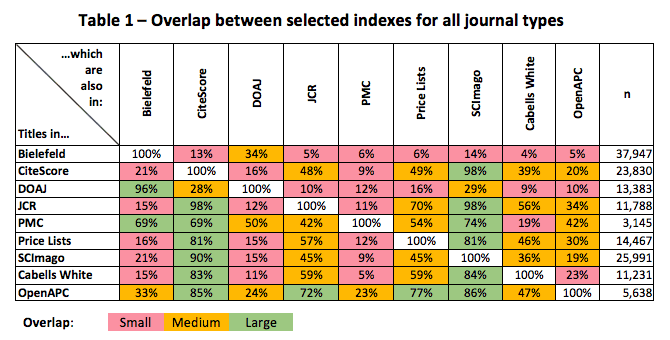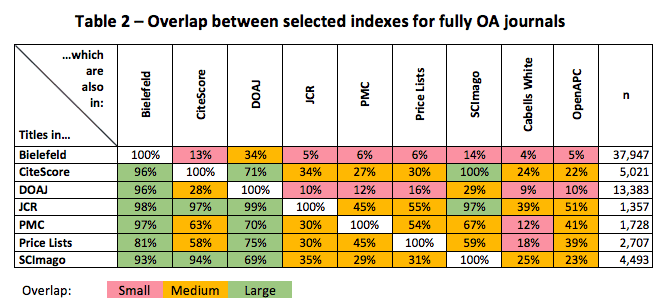Last month we started looking at whether it’s possible to find definitive information about where to publish, and about which journals are fully open access. We looked at the sizes of various indexes to see how comprehensive they are, but noted that size is only part of the story. This month we look at how indexes overlap, and whether we can get to a definitive source.
Background
Some indexes, of course, are more exclusive than others. Different indexes take different approaches and have different objectives. For example, the selection processes used by Cabells, Clarivate, the DOAJ, and Elsevier illustrate the breadth of issues covered when determining journal quality. Even where similar types of criteria are used, their specific application or thresholds may differ.
By analyzing titles that sit in multiple indexes we can determine the overlap and gaps between each index and get a sense of whether we need to shop around across indexes to gather a comprehensive list of titles.
In theory, titles should have ISSNs that uniquely identify them. In practice, one title may have several ISSNs, for example for a print version and an online version. To facilitate working with journal lists, theInternational ISSN Centre (which oversees ISSNs) designates just one ISSN from each journal as its “definitive” identifier, which is known as its linking ISSN, or ISSN-L.
Bielefeld University’s work on producing a definitive list of fully OA ISSNs from public sources uses the ISSN-L to identify and count titles. We have used a similar approach. We linked lists of ISSNs in indexes back to their parent ISSN-Ls, removed duplicates, and then considered a title to sit in two indexes if its ISSN-Ls appeared in each. Despite the 2 million or so ISSN-Ls registered, ambiguities still apply, such as titles with more than one parent ISSN-L, titles with no parent ISSN-L at all, and some with no ISSNs at all.
Relative Index Coverage
We start by looking at the overlaps between indexes for all journals, shown in Table 1, below.

Sources: Indexes as stated, readings taken Jun/Jul 2019. Delta Think analysis. © Delta Think 2019, All rights reserved.
The table lists various indexes down its left-hand side. Reading across the table, it shows what proportion of each index’s titles appear in other indexes. So, for example, 28% of the DOAJ’s titles also appear in Elsevier’s CiteScore. Percentages do not add up to 100% as titles may appear in more than one index.
The n column shows the total number of titles (technically, unique ISSN-Ls) within each index, so you can get a sense of scale. The table also is overlaid with a heatmap.
- The more exclusive JCR shows a significant overlap with the Scopus-derived indexes, suggesting the one is a subset of the other.
- The Price Lists row (which shows Delta Think’s sample of journal APCs from the 30 or so largest publishers), shows that 81% of their journals appear in Scopus and 57% in the JCR.
- The Bielefeld row (showing the Gold OA list mentioned above) is designed to be inclusive, so it has many titles that do not appear in other (more exclusive) indexes.
- PMC is a relatively small index, so only accounts for a small proportion of many indexes. However, the journals in PMC are widely indexed elsewhere.
Fully OA Journals
We can also look at the overlaps for just fully OA journals, as shown in Table 2, below.

Sources: Indexes as stated, readings taken Jun/Jul 2019. Delta Think analysis. © Delta Think 2019, All rights reserved.
The table filters the “Titles in” column for fully OA journals, as designated by their parent indexes. We did not have detailed information for all indexes, so their rows are not shown.
- The dedicated full OA indexes (Bielefeld and DOAJ) show no change in their overlaps, as filtering for OA will not change their lists.
- Most of the JCR’s OA journals are in the DOAJ, compared with 71% of the Scopus-derived ones. This suggest the latter are casting a wider net in some respects than the DOAJ.
- The reverse is true too, with only small proportions of the DOAJ’s journals overlapping with the major indexes.
- The small overlaps between the dedicated fully OA indexes suggest that they are capturing different sets of journals.
- We have excluded CrossRef as a source, as we wish to focus on curated lists. At the time of writing we did not have information about Web of Science ISSNs, however studies have shown a high degree of overlap between WoS and Scopus2.
Definitive Coverage
So, is there a one-stop shop? The spread of index coverage is further illustrated in Figure 1, below.

All journals, n=43,840; Fully OA journals, n=15,687.
Source: Delta Think analysis. © Delta Think 2019, All rights reserved.
The figure shows how many different indexes ISSN-Ls appear in, expressed as a proportion of our overall sample. For example (as illustrated in the two left-most grey bars), just over 50% of all ISSN-Ls we analyzed only appear in one index, and around 15% only appear in two indexes. The chart does not analyze whether these are in the same index – it simply analyzes the likelihood of having to look in more than one index to find a given title. The chart does not include the inclusive Bielefeld Gold list, as we are trying to analyze the more selective indexes.
Taken in conjunction with the table showing overlap, the data suggest that no one index can offer anything approaching comprehensive coverage. At least half of all titles, and two-thirds of fully OA ones exist exclusively in only one index, but there is no way to predict which one.
Conclusions
We set out to examine whether there is a definitive, curated list of journals that researchers can use when deciding on their publication venue. While some offer very good coverage, the short answer appears to be that no one index offers a definitive list.
Across all journals, there seems to be overlap of significant proportions of the mainstream indexes. However, fully OA journals present a more varied landscape. You need to combine multiple lists to round up a comprehensive list of curated fully OA journals.
Our analysis has combined over 100,000 ISSNs across over 65,000 titles and, we think it represents one of the most comprehensive round ups of the coverage of curated lists available.
Notes:
1 – When measuring exclusivity, note that CiteScore and SCImago both derive from Scopus data, so we count them as one index to avoid double-counting.
2 – Web of Science coverage overlapping Scopus, see, for example, Mongeon, P. & Paul-Hus, A. Scientometrics (2016) 106: 213. https://doi.org/10.1007/s11192-015-1765-5

TOP HEADLINES
Global Medical Publishing Market 2019-2023: Transition Toward OA Publishing Model to Boost Growth – August 14, 2019
“The global medical publishing market is expected to post a CAGR of more than 3% during the period 2019-2023, according to the latest market research report by Technavio. However, the market’s momentum will decelerate in the coming years because of the decrease in year-over-year growth.”
MIT announces “Mind the Gap,” a major report on all available open-source publishing software – August 8, 2019
“Mellon-funded report Mind the Gap: A Landscape Analysis of Open Source Publishing Tools and Platforms catalogs and analyzes all available open-source software for publishing and warns that open publishing must grapple with the dual challenges of siloed development and organization of the community-owned ecosystem.”
VIVA and Wiley Drive Open Access with Progressive New Agreement – August 7, 2019
“John Wiley & Sons, Inc. and The Virtual Library of Virginia (VIVA), Virginia’s academic library consortium, announced the signing of a comprehensive agreement which combines open access publishing funds with their journal subscriptions…The two-year pilot utilizes the Wiley Open Access Account solution to allow VIVA researchers to publish in fully gold open access journals using a central fund for article publication charges.”
Cambridge University Press announces open research platform – August 6, 2019
“Cambridge University Press is to expand their provision of open research services with the launch of its own early and open content platform Cambridge Open Engage. Built in-house, Cambridge Open Engage will use the state-of-the-art technology behind Cambridge Core, the online home for the Press’s books and journals, to publish early and open research outputs.”
DeepGreen Partnering with Publishers and Universities in Distributing Open Access Content to Institutional Repositories – August 2, 2019
“Recently, the DeepGreen initiative in Germany started into an advanced test phase with the publishing partners as well as 27 universities from all over Germany. DeepGreen aims at lowering the barriers for open access publishing by automatically delivering metadata and full text publications from participating publishers to authorized repositories at German universities.”
OA Monographs in Europe’s Research Libraries: Best-Practices, Opportunities & Challenges – July 26, 2019
“Over 80% of surveyed LIBER libraries say they distribute Open Access (OA) books via a repository and include them in discovery services or catalogues. A further 40% publish OA books, or plan to do so, and a quarter provides library funding to pay author fees related to OA book publishing.”
The British Academy publishes commentary on cOAlition S’s final version of Plan S –
July 23, 2019
“The British Academy has published a new commentary on cOAlition S’s final version of ‘Plan S’ for open access publishing, and once again voiced concerns over the initiative.”
Figshare announces data repository partnership with the National Institutes of Health to store and reuse research data – July 23, 2019
“Figshare, in partnership with the National Institutes of Health (NIH), announces the pilot launch of a new generalist data repository for all NIH-funded researchers, continuing the NIH’s efforts toward a permanent home for all datasets generated by the research funded by the NIH.”
IntechOpen joins OASPA – July 23, 2019
“As part of its commitment to quality and standards in Open Access book publishing, IntechOpen has joined the Open Access Scholarly Publishers Association (OASPA).”
The open access mandate: Be careful what you wish for – A Plan S Summary” – July 21, 2019
“In its opening move, Plan S describes 10 principles on how it plans to run. Some are vague and open to interpretation, while others are straightforward, like the unpopular measure banishing grantees from publishing in hybrid journals, which already provide the opportunity for open-access publishing. The decision is controversial, and the debate is heated.”
OA JOURNAL LAUNCHES
July 25, 2019 | Wolters Kluwer Partners with the Chinese Medical Association to Launch Maternal-Fetal Medicine | “Wolters Kluwer Health announced today it has partnered with the Chinese Medical Association (CMA) to launch Maternal-Fetal Medicine (MFM), an open access journal focused on the field of obstetrics and maternal-fetal medicine.” |
July 19, 2019 | “European Psychiatry – the official journal of the European Psychiatric Association (EPA) – is to become fully open access in 2020. The announcement coincides with that of the journal’s move to Cambridge University Press and means anyone will be able to read the research it publishes online and free of charge.” |

